On a clear, cold morning in early December, I climbed into the cockpit of a K-1200 K-MAX at Kaman’s corporate headquarters in Bloomfield, Conn. The K-MAX cockpit seats exactly one; this morning, I was it. I strapped into my seat with a five-point harness and pulled out the laminated checklist I would use to bring the aircraft to life. Nose wheel — locked. Parking brake — set. Standing next to me on the ramp was Kaman’s chief pilot Bill Hart, who monitored my progress through the aircraft’s open left-side bubble window. He wouldn’t be there long — just long enough to ensure that my first start went off without a hitch.

The K-1200 pilot training course at Kaman’s headquarters in Bloomfield, Conn., is not your typical transition course. Fewer than 250 pilots have been checked out in the aircraft over its two decades of operation.
Area — clear. Anti-collision light — on. Start trigger — pull and hold to 36 percent NG.
The Honeywell T5317-A1 engine began spooling up; above my head, the K-MAX’s intermeshing main rotor blades started their slow acceleration. Off the nose of the aircraft, the mechanic serving as my ground crew held up two fists, thumbs extended inward — droop stops in. As I rolled the throttle to flight idle and the rotor blades picked up speed, he rotated his thumbs outward — droop stops out.
Generator — on. Particle separator — on. Flight controls — check.
After checking my flight controls, I rolled the throttle fully open. Hart closed the bubble window and retreated into the warmth, and safety, of the K-MAX hangar, where he could communicate with me over a handheld VHF radio while watching me through a window. I nervously ran through my pre-takeoff checks: beeping up the rotor r.p.m., releasing the parking brake. Was there anything I was forgetting? I sure hoped not. I was on my own now, about to make my first flight in an aircraft I had never flown before; an aircraft that handled significantly differently than the tail-rotor-equipped helicopters in which I had logged 99 percent of my flight time. The prospect was every bit as thrilling and intimidating as my first helicopter solo had been, 10 years earlier.
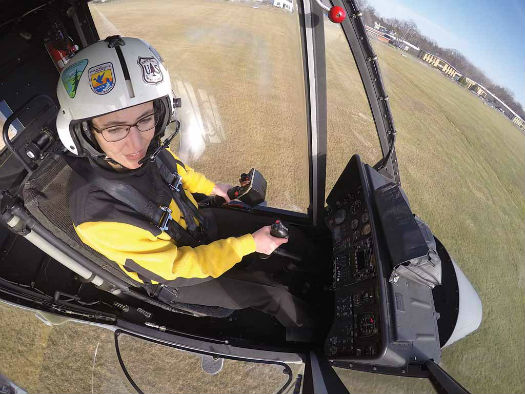
Vertical’s Elan Head at the controls of the K-MAX. With no room for passengers, the K-MAX has been described as the ultimate pilot’s helicopter. Its narrow cockpit is ideal for vertical reference operations.
OK, here goes.
I began raising the collective at a snail’s pace, double-checking to make sure that my feet — accustomed to working a tail rotor — were, instead, keeping the pedals centered. As the K-MAX became light on the wheels, I added just enough forward cyclic to counteract the torque of the offset main rotor system; then, right before lift-off, a little aft cyclic to keep the nose level. Slowly, the aircraft picked up into a stable hover. GoPro video of this moment shows that I was frowning with concentration, as if relying on willpower alone for levitation, rather than a 1,500-shaft-horsepower turbine engine. But this expression didn’t last for long. As I accelerated into forward flight and cleared the line of trees just past the hangar, I broke into a huge grin.
It was happening. I was flying a K-MAX.
The Eye of the Beholder
Originally certified in 1994, the Kaman K-1200 K-MAX may be the most distinctive helicopter model currently in operation, even if it is not generally regarded as the most beautiful. I’ve heard cruel things said about the appearance of the K-MAX, which has two bewildering main rotor systems chopping up the air over a narrow, somewhat aardvark-shaped fuselage. But I don’t care who thinks it’s ugly — for me, the K-MAX was love at first sight. When I saw my first K-MAX landing at a fire helibase in Arizona nearly a decade ago, I barely recognized it as a helicopter, but I knew within 10 minutes of talking to the pilot that this was what I wanted to fly.
Even if you question its aesthetics, there’s much about the K-MAX that demands respect. The descendant of Charles Kaman’s pioneering line of synchropters, the K-MAX was designed for one purpose only: repetitive external lifting operations. It is most recognizable for its intermeshing main rotors, which turn in opposite directions “like a swimmer doing the breaststroke,” as Kaman’s instructors put it. This counter-rotation cancels out the torque of each rotor around the yaw axis, eliminating the need for — and power draw of — a tail rotor. In combination with a minimalist airframe, the synchropter design makes an extraordinary amount of power available for lifting; the K-MAX has an empty weight of 5,150 pounds (2,336 kilograms), but can carry up to 6,000 pounds (2,721 kilograms) on the cargo hook (for a maximum gross weight of 12,000 pounds / 5,443 kilograms). To put this in perspective, consider that the K-MAX has practically the same engine as the Bell 205, but, compared to the 205, can lift nearly twice as much weight in the form of an external load.
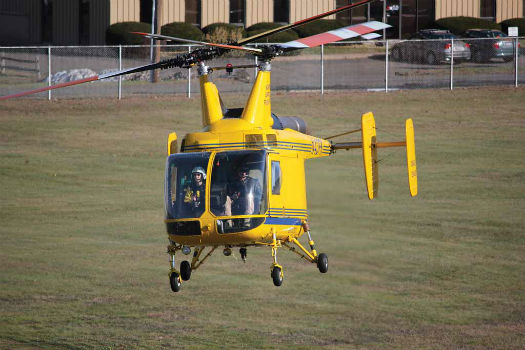
Initial training on an HH-43 Huskie gives pilots valuable experience with an intermeshing rotor system before jumping into the K-MAX.
The K-MAX is unique not only for its intermeshing rotor system, but also for how that rotor system is controlled. In conventional helicopters, pilot control inputs change the pitch of the main rotor blades at their root. In helicopters made by Kaman — which, in addition to the civilian K-MAX, include the H-43 Huskie and SH-2 Seasprite — the pilot is instead controlling smaller airfoils called servo flaps that are attached to the trailing edge of the main rotor blades, around three-quarters of the way toward their tips. Similar in effect to ailerons on an airplane, these servo flaps use aerodynamic forces to change the pitch of the main rotor blades; when the leading edge of the servo flap moves down, the leading edge of the main rotor blade moves up. (On the Huskie and K-MAX, which have main rotor blades made largely from wood, the blades actually twist to accomplish these pitch changes.)
Because the forces required to manipulate the servo flaps are much lower than those required to control the rotor blades directly, the K-MAX does not require hydraulic flight control servos, which reduces costs and simplifies field maintenance. A hydraulic system has been designed for the aircraft — and, by all accounts, is a pleasure to fly with — but it’s expensive, and no operators have installed it. To make things a little easier on the pilot, the cyclic incorporates lateral and longitudinal spring struts, which are controlled by a four-way beeper trim switch on the cyclic stick grip — making it something like a 12,000-pound-gross-weight MD500.

Getting a briefing from Kaman chief pilot Bill Hart before that momentous first flight. Hart said that while most pilots who come through the course are apprehensive about their first flight in the K-MAX, “Once they pick up into a hover and fly around, they realize it’s not a big deal.”
With only one seat and a limited cargo compartment, the K-MAX is obviously a niche aircraft. Only a few dozen aircraft were made before production ceased in 2003, and only 21 of those are still flyable today. Recently, however, the future of the K-MAX has been looking up. Two unmanned examples of the K-MAX made valuable contributions for the U.S. Marine Corps in Afghanistan, delivering 4.5 million pounds of cargo to front-line troops during their three years in theater. Although one of those aircraft sustained extensive damage in a loss-of-control accident, Kaman and partner Lockheed Martin still see great potential for the unmanned K-MAX, and have been demonstrating it for firefighting and other possible missions.
For those of us who still fly helicopters the old-fashioned way, Kaman has also been exploring a return to commercial production of the K-MAX — meaning that new aircraft could be rolling off the production line by 2017. It was in this hopeful context that I was able to join an initial K-1200 pilot transition class at Kaman’s headquarters in December 2014, to learn first-hand what it takes to operate this unique machine. This giant leap for me would also be a small step forward for womankind, as I would become the first female pilot in the world to fly the K-MAX.
Right. No pressure.

Post-flight with Tim Graham of K-MAX product support, left, and chief pilot Bill Hart. The aircraft used for the flight is owned by Lockheed Martin, Kaman’s partner in the unmanned K-MAX program.
Theory and Practice
I began preparing for my date with the K-MAX well in advance of the two-week transition class, mostly by spending quality time with the flight manual. That was a good way to become familiar with the basic specifications and limitations of the aircraft — for example, the never-exceed speed (80 knots with a load, 100 knots without) and the maximum operating altitude (15,000 feet, although Kaman told me that’s more of a testing limitation than an aerodynamic one). I reviewed the principles of the Honeywell T53 engine, and downloaded the K-1200 maintenance manual to learn a bit more about the aircraft’s systems. Nevertheless, I arrived in Connecticut with a long list of questions. How exactly does this “differential cyclic” stuff work? Why are there two different torque limits, depending on whether the aircraft is loaded or unloaded?
Tim Graham, the ground instructor for the class, was more than ready for me. A longtime member of Kaman’s product support team, Graham has been teaching pilots and mechanics about the K-MAX for two decades, and it shows — he’s a fantastic instructor who knows the K-1200 inside and out. Kaman’s instructional facilities aren’t fancy (essentially, just a single room inside the K-MAX maintenance hangar) but what the training lacks in flash, it makes up for in quality. And it has to. Kaman is training pilots who will often be working independently in the field; who need to know how to perform a maintenance test flight, not just wiggle the sticks. By the end of the course, I was flying a US$7-million Kaman-insured aircraft on a solo cross-country to an external load training area. Can you think of another commercial helicopter manufacturer that demonstrates the same level of confidence in the adequacy of its transition training?
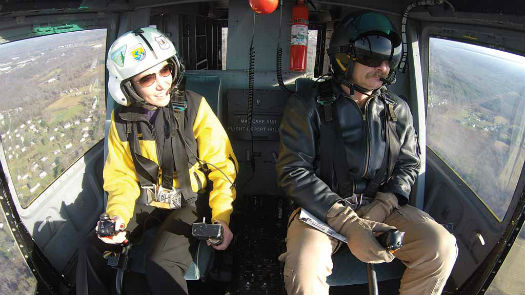
Flying the HH-43 is a rare experience in itself. With Kaman’s Huskies nearing the end of their useful lives, however, Kaman is exploring other options for K-MAX pilot training, such as simulator training.
I was in a class of two along with Raffaello Milani, a new pilot for Rotex Helicopter in Switzerland. Over the next 10 days, Graham walked us through every system on the aircraft in detail: from the transmission and rotor systems, to the lighting and electrical. We peered inside a K-MAX control module to see how cyclic and collective inputs are mechanically translated for the aircraft’s intermeshing rotor system. We toured Kaman’s blade shop, where Graham explained why high torque settings place excessive stress on unloaded rotor blades. We learned how to do a proper preflight — it’s unusually comprehensive on the K-MAX — and how to fold the blades back for hangar storage. We reviewed maintenance test procedures to better understand what we would be practicing in the air.
Meanwhile, we jumped straight into flying with chief pilot Bill Hart. Kaman doesn’t have a two-seat training version of the K-MAX, but it does have the next best thing: the H-43 Huskie, the Kaman synchropter on which the K-MAX is based. The Huskie design dates to 1947, a time when aerodynamic efficiency and stylish good looks weren’t quite the priorities that they are today. The 1962 B-model that Milani and I trained on looked like a breadbox and shook like an out-of-balance washing machine, but it was an interesting aircraft in its own right. More to the point, it gave us valuable experience flying an intermeshing rotor system, which differs in some key ways from the rotor systems on conventional helicopters.
Collective inputs on an intermeshing rotor system are pretty straightforward. Raising the collective increases the pitch on all four blades collectively and equally, and lowering the collective reduces the pitch. As in conventional helicopters, engine power is synchronized with pitch changes to maintain a constant rotor r.p.m. The most obvious point of difference with a tail-rotor helicopter is that yaw pedal inputs are not required with power changes, because the counter-rotating main rotors cancel each other’s torque. That’s actually not too difficult to get used to — in any helicopter, you wouldn’t input yaw pedal to stop a rotation that wasn’t happening.
However, main rotor torque comes into play in a more unexpected way, because the main rotor masts are slightly canted from vertical. Imagine continuing that tilt until the rotor masts are perfectly horizontal and the main rotors are turning in the same direction, like the wheels on a car. Now the torque effect will clearly be opposite to the direction of rotation. Even with a minor amount of tilt, that torque effect causes a noticeable pitching moment up when power is increased, and down when power is reduced. On the K-MAX, the collective is coupled to an elevator on the tailboom to compensate for that pitching moment in forward flight, but the effect is still significant, particularly when entering autorotation.
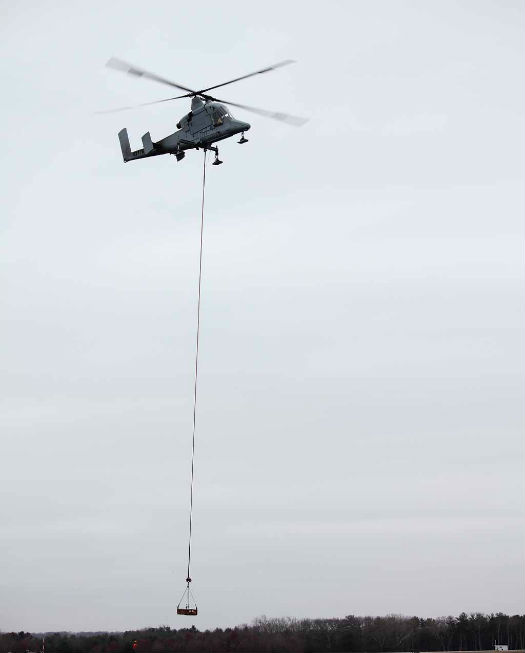
The K-MAX can carry up to 6,000 pounds on its cargo hook. The aircraft is shown here with a 2,000-pound load, which it handled with ease.
Cyclic control is quirkier still. Forward cyclic causes both rotor discs to tilt forward by an equal amount; aft cyclic causes them both to tilt aft. Moving the cyclic stick to the right, however, results in only the right rotor disc tilting right, and left cyclic results in only the left rotor tilting left (as you wouldn’t want the rotor discs tilting into each other). This means that the intermeshing rotor system has twice the control authority fore and aft as it does left and right — a characteristic that can lead to overcontrolling in a hover until you get the hang of it.
Then there’s the directional control system, which is where things really get weird. The effect of pedal input in a conventional helicopter is pretty simple — it just changes the pitch of the tail rotor blades. In the intermeshing rotor system, it’s more complicated. Inputting right pedal, for example, causes the left rotor to increase in pitch and the right rotor to decrease in pitch (differential collective). With the left rotor producing more torque, the helicopter tends to turn to the right. This effect is augmented by differential cyclic: the left rotor tilts forward, and the right rotor tilts aft, causing them to “push” and “pull” in a turn much as oars are used to turn a rowboat. One consequence of this arrangement is that the aircraft tends to roll in the direction of a pedal turn, which in a hover requires opposite cyclic to keep the aircraft level.
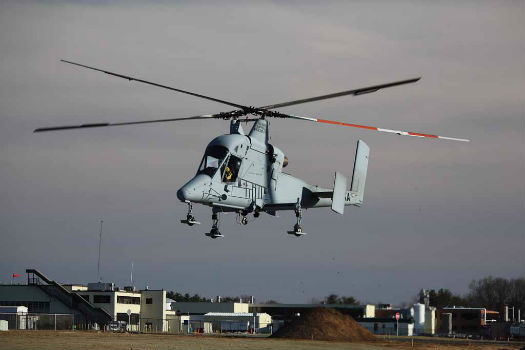
The K-MAX uses the Honeywell T5317-A1 engine, which is no longer in production. That won’t be an obstacle to new aircraft production, however, as Kaman has coordinated with the FAA on an approved process to rebuild zero-time engines from T5313-B cores.
But there’s a catch! In autorotation, when engine torque is no longer a factor, the rotor with the higher pitch experiences greater transmission drag, causing the aircraft to turn in the direction of that rotor. So, if the design didn’t compensate for it, right pedal in an autorotation would actually result in the helicopter turning to the left — a confusing state of affairs that would be particularly difficult to cope with during an emergency. Kaman’s solution to this is a clever “reverser” mechanism in the control module that actually reverses the effect of pedal inputs at low collective settings, so that the helicopter flies intuitively in power-off as well as power-on flight. However, the need to swap differential collective inputs results in a “dwell zone” at moderate collective settings, at which differential collective is near zero and differential cyclic becomes the primary turning force. That results in a noticeable decrease in directional authority when the collective is in the dwell zone — for example, during low-power descents.
Kaman gave us plenty of time to get used to these quirks in the Huskie. The K-1200 transition syllabus calls for eight flights in the H-43 before jumping into the K-MAX, including plenty of autorotations, hovering autorotations, and other emergency procedures. I ended up with a little over six hours in the H-43, which was a pretty decent transition course in itself. And I have to say that, despite the anxiety associated with that first, solo K-MAX flight, I was perfectly well prepared for it. There were no real surprises on the flight — just the pleasure of controlling a relatively smooth, modern helicopter after six hours of bouncing around in a flying breadbox.

Tim Graham said that Kaman’s goal in training is to impart as much knowledge and hands-on experience as possible. “The pilot needs to know the systems as well as the mechanic does . . . because they’re going to work as a team to keep [the aircraft] maintained,” he said.
Welcome to the Club
Kaman’s K-1200 transition syllabus includes nine flights in the K-MAX, although each flight is fairly short, at just 35 to 50 minutes. Per the syllabus, the first two flights are basic familiarization flights, involving hovering, pick-ups and set-downs, ground taxiing, and normal and confined-area takeoffs and approaches. The third and fourth flights emphasize autorotations, while flights five through eight provide practice in external load operations, the aircraft’s raison d’être. Finally, there’s a flight devoted to maintenance test procedures (which, due to weather and scheduling, Milani and I completed early).
Besides the most general question — “What is it like to fly?” — what most helicopter pilots want to know about the K-MAX is, “How does it auto?” The answer: pretty well. Rotor r.p.m. is very slow to decay in an autorotation, thanks to the aircraft’s high-inertia rotor blades and the tendency of the servo flaps to automatically reduce blade pitch in response to the change in airflow. In fact, you should deliberately wait to lower the collective after entering an autorotation in the K-MAX — lowering it too quickly results in a dramatic nose-down pitch that is, to say the least, very uncomfortable. Entering my first autorotation in the K-MAX was almost as nerve-racking as picking up into that first hover, but after three or four practice autorotations, I started to enjoy them.

The K-MAX fleet is small but hardworking. Over 20 years, the worldwide fleet has accumulated more than 315,000 flight hours, with many aircraft flying 1,000 hours per year or more. Kaman is hopeful that total will grow significantly over the aircraft’s next two decades of operation.
As for external load operations, well, bear in mind that my most recent vertical reference experience was three hours of slinging a tire around with a Bell JetRanger in 2011 (see p.64, Vertical, June-July 2012). However, since no self-respecting civilian helicopter pilot can call herself a K-MAX pilot without throwing on a long line, I was determined to give it my best. While Milani — an experienced logging pilot — amused himself by maneuvering 5,000-pound (2,268-kilogram) loads into small clearings surrounded by trees, I started in an open field with an empty hook on a 100-foot line, gradually working up to a 2,000-pound (907-kilogram) load. Needless to say, Rotex won’t be looking to hire me anytime soon. But it does imply a lot about the aircraft’s prowess as a lifter that a 2,000-pound load beneath a K-MAX wasn’t significantly harder for me to manage than a tire beneath a JetRanger.
Certainly, the K-MAX has its shortcomings. It’s an idiosyncratic aircraft that would greatly benefit from some key upgrades, such as a redesign of the rotor system to accommodate modern composite rotor blades. And it’s not exactly versatile — forget about using it for anything other than moving heavy stuff around. But I’m not the most objective person to ask about these shortcomings, because I concluded my training as completely in love with the K-MAX as I had been to begin with. Now, I’m also a member of an exclusive club; according to Kaman, fewer than 250 pilots have flown the aircraft over the two decades since it was originally certified.
If the K-MAX re-enters production, that number should increase significantly. I hope that it does (and I hope, too, that a greater number of the next generation of K-MAX pilots will be women). In the meantime, my training at Kaman ranks as a highlight of my career. Learning to fly a K-MAX is a little taste of being a test pilot — a chance to experience a completely novel aircraft entirely on your own, in a way that most people never will. What pilot could turn down an opportunity like that?






Looking for a used K-MAX.
I’m a former Navy CH-46D pilot (really dating myself here) who flew briefly for Columbia Helicopters (BV107 and BV234) as a co-pilot. I have long wondered what these machines are like to fly. Now I have an idea. I also long wondered why the layout was not used in more applications and I think I understand why now. It has a narrow niche but it seems to excel in that niche so it surprises me so few have been sold. Maybe Kaman will make a twin engine high powered heavy lifting beast to compete with my beloved old tandem rotors? Single pilot too! Well, one can hope.
I flew 46’s for HC-6/8, retired in 2012, took this K-MAX training to run the UAS program for Lockheed Martin in Afghanistan. PM me on FB with any questions. r/Phil